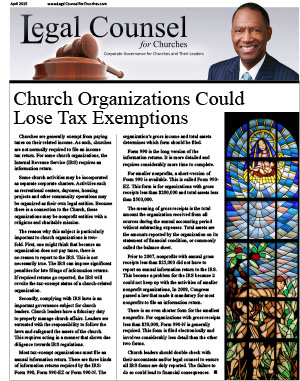Churches are generally exempt from paying
taxes on their related income. As such, churches
are not normally required to file an income
tax return. For some church organizations, the
Internal Revenue Service (IRS) requires an
information return.
Some church activities may be incorporated as separate corporate charters. Activities such as recreational centers, daycares, housing projects and other community operations may be organized as their own legal entities. Because there is a connection to the Church, these organizations may be nonprofit entities with a religious and charitable mission.
The reason why this subject is particularly important to church organizations is two- fold. First, one might think that because an organization does not pay taxes, there is no reason to report to the IRS. This is not necessarily true. The IRS can impose significant penalties for late filings of information returns. If required returns go reported, the IRS will revoke the tax-exempt status of a church-related organization.
Secondly, complying with IRS laws is an important governance subject for church leaders. Church leaders have a fiduciary duty to properly manage church affairs. Leaders are entrusted with the responsibility to follow the laws and safeguard the assets of the church. This requires acting in a manner that shows due diligence towards IRS regulations.
Most tax-exempt organizations must file an annual information return. There are three kinds of information returns required by the IRS: Form 990, Form 990-EZ or Form 990-N. The organization’s gross income and total assets determines which form should be filed.
Form 990 is the long version of the information returns. It is more detailed and requires considerably more time to complete.
For smaller nonprofits, a short-version of Form 990 is available. This is called Form 990- EZ. This form is for organizations with gross receipts less than $200,000 and total assets less than $500,000.
The meaning of gross receipts is the total amount the organization received from all sources during the annual accounting period without subtracting expenses. Total assets are the amounts reported by the organization on its statement of financial condition, or commonly called the balance sheet.
Prior to 2007, nonprofits with annual gross receipts less than $25,000 did not have to report an annual information return to the IRS. This became a problem for the IRS because it could not keep up with the activities of smaller nonprofit organizations, In 2008, Congress passed a law that made it mandatory for most nonprofits to file an information return.
There is an even shorter form for the smallest nonprofits. For organizations with gross receipts less than $50,000, Form 990-N is generally required. This form is filed electronically and involves considerably less detail than the other two forms.
Church leaders should double check with their accountants and/or legal counsel to ensure all IRS forms are duly reported. The failure to do so could lead to financial consequences.

